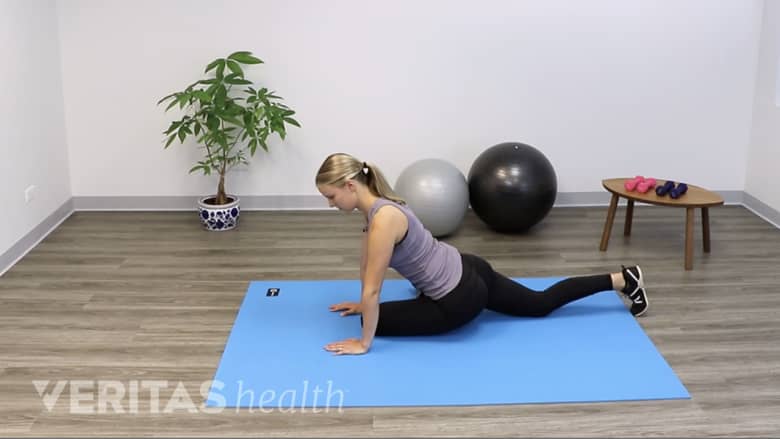Static and dynamic yoga postures can help reduce sacroiliac (SI) joint pain by strengthening and stabilizing your lower back, hip, and core muscles, increasing flexibility in your hip and spine, and preventing future reoccurrence of pain.1Fishman L. Healing Yoga: Proven Postures to Treat Twenty Common Ailments – from Backache to Bone Loss, Should Pain to Bunions, and More. W.W. Norton & Company; 2015.
Benefits of yoga for SI joint pain
SI joint pain can occur due to inflammation within the joint (sacroiliitis) or abnormal movement of the joint (SI joint dysfunction).2Buchanan BK, Varacallo M. Sacroiliitis. [Updated 2022 Sep 4]. In: StatPearls [Internet]. Treasure Island (FL): StatPearls Publishing; 2022 Jan-. Available from: https://www.ncbi.nlm.nih.gov/books/NBK448141 Over time, these conditions can make the muscles around SI joint weak or imbalanced, placing additional stress on the joint and worsening the symptoms.2Buchanan BK, Varacallo M. Sacroiliitis. [Updated 2022 Sep 4]. In: StatPearls [Internet]. Treasure Island (FL): StatPearls Publishing; 2022 Jan-. Available from: https://www.ncbi.nlm.nih.gov/books/NBK448141 Strengthening and stretching these muscles through yoga can help improve the stability and alignment of the joint, which may help reduce pain and prevent further injury.3Zelle BA, Gruen GS, Brown S, George S. Sacroiliiac joint dysfunction: evaluation and management. Clin J Pain. 2005; 21:446-355. https://pubmed.ncbi.nlm.nih.gov/16093751
Yoga for SI joint pain primarily focuses on stretching and strengthening the lower back muscles, deep gluteal muscles (like the piriformis muscle), and hip extensor muscles (like the gluteus maximus and the hamstrings). Building strength and resilience in these muscle groups can help improve overall posture and body mechanics, further reducing stress on the SI joint.1Fishman L. Healing Yoga: Proven Postures to Treat Twenty Common Ailments – from Backache to Bone Loss, Should Pain to Bunions, and More. W.W. Norton & Company; 2015.
Here are 4 easy and effective yoga stretches for SI joint pain that you can do at home using a yoga mat.
Downward dog
The downward dog pose is effective at stretching the entire spine and works well to stretch the lower back, hip, and hamstring muscles.
To perform the downward dog, begin on your hands and knees with your wrist under your shoulder and fingers spread wide.
- Tuck your toes under and engage your stomach muscles.
- Press into your hands and push your body up off the mat so only your hands and feet are on the mat.
- Using your hands for support, move your chest closer to your thighs as much as possible while keeping your feet flat on the floor.
- Relax your face and neck.
Begin holding the downward dog pose for 3-5 breaths initially and slowly work up to 5-10 breaths. Aim to complete one set of three stretches daily.
Pigeon pose
The pigeon pose stretches several muscles, including the deep gluteal muscles, such as the piriformis muscle, the hip extensor muscles, such as the gluteus maximus and the hamstrings, and the lower back muscles.4Kushner AM, Brent JL, Schoenfeld BJ, et al. The Back Squat Part 2: Targeted Training Techniques to Correct Functional Deficits and Technical Factors that Limit Performance. Strength Cond J. 2015;37(2):13-60. http://doi.org/10.1519/SSC.0000000000000130,5Lehecka BJ, Stoffregen S, May A, et al. Gluteal Muscle Activation During Common Yoga Poses. Int J Sports Phys Ther. 2021;16(3):662-670. Published 2021 Jun 1. http://doi.org/10.26603/001c.22499
To perform the pigeon pose, begin on all fours, with hands and knees positioned under the shoulders and hips, respectively.
- Bend one knee and tuck the leg underneath the body.
- Fold the body over the top of the bent leg.
- Keep the opposite leg stretched out straight with toes pointing to the floor.
- Reach forward, as much as possible, without pain.
Hold the pose for 5 deep breaths and slowly return to the starting position. Aim to complete one set of three stretches on each side.
Cow-cat pose
The cow-cat pose stretches the spine and helps increase lower back and hip mobility.1Fishman L. Healing Yoga: Proven Postures to Treat Twenty Common Ailments – from Backache to Bone Loss, Should Pain to Bunions, and More. W.W. Norton & Company; 2015.,6Telang A, Iyer SS, Saoji K, Gawande V. Treating of Joint Pain – Arthritis through YOGA. Journal of Pharmaceutical Research International. 2021;33(37B):283-288. https://doi.org/10.9734/jpri/2021/v33i37B32051
To perform the cow-cat pose, begin on your hands and knees with your wrists under your shoulders and your knees under your hips.
- Inhale, arch your back and lift your head and tailbone towards the ceiling (cow pose).
- Exhale, round your spine, and bring your chin towards your chest (cat pose).
Repeat for 5-10 breaths, moving slowly between cow pose and cat pose. Aim to complete one set of five stretches daily.
Bridge pose
The bridge pose both strengthens and stretches the muscles of the lower back and hips.5Lehecka BJ, Stoffregen S, May A, et al. Gluteal Muscle Activation During Common Yoga Poses. Int J Sports Phys Ther. 2021;16(3):662-670. Published 2021 Jun 1. http://doi.org/10.26603/001c.22499
To perform the bridge pose, begin by lying on the back with both legs straightened out and flat on the ground.
- Slowly bend both knees while keeping feet flat on the ground, and toes pointed straight forward.
- Lay the arms flat on the side of the body with palms facing down.
- Inhale, slowly raise the hips while engaging the abdominal and buttock muscles.
- Lift the hips as high as possible, without pain, to make a straight line from the shoulder to the knee.
- Hold for 5-10 breaths, then release.
Begin holding the bridge pose for 1-2 breaths initially and slowly work up to 5-10 breaths. Aim to complete one set of three stretches daily.
Can yoga irritate the SI joint: Precautions while performing yoga
Yoga can be an effective, low-impact way to relieve SI joint pain. However, yoga must be avoided in specific circumstances, or it should be practiced under the guidance of a therapist. These situations include:
- If you take medication(s) that may cause sedation or make you drowsy.
- If you have a medical condition that causes your ligaments and joints to be more flexible than normal (hypermobile).7Dacci P, Amadio S, Gerevini S, et al. Practice of yoga may cause damage of both sciatic nerves: a case report. Neurol Sci. 2013;34(3):393-6. http://doi.org/10.1007/s10072-012-0998-9
Often, a particular pose may help one person, but it may not work for others. You may need to try different yoga poses to find the most effective stretch to relieve your SI joint pain. When in doubt about a pose or if a yoga posture causes sudden pain, it is advisable to see medical help.
The poses themselves may be uncomfortable, particularly at first, but careful, gentle, and gradually progressive practice can help alleviate the uncomfortable symptoms of SI joint pain.
Learn more:
- 1 Fishman L. Healing Yoga: Proven Postures to Treat Twenty Common Ailments – from Backache to Bone Loss, Should Pain to Bunions, and More. W.W. Norton & Company; 2015.
- 2 Buchanan BK, Varacallo M. Sacroiliitis. [Updated 2022 Sep 4]. In: StatPearls [Internet]. Treasure Island (FL): StatPearls Publishing; 2022 Jan-. Available from: https://www.ncbi.nlm.nih.gov/books/NBK448141
- 3 Zelle BA, Gruen GS, Brown S, George S. Sacroiliiac joint dysfunction: evaluation and management. Clin J Pain. 2005; 21:446-355. https://pubmed.ncbi.nlm.nih.gov/16093751
- 4 Kushner AM, Brent JL, Schoenfeld BJ, et al. The Back Squat Part 2: Targeted Training Techniques to Correct Functional Deficits and Technical Factors that Limit Performance. Strength Cond J. 2015;37(2):13-60. http://doi.org/10.1519/SSC.0000000000000130
- 5 Lehecka BJ, Stoffregen S, May A, et al. Gluteal Muscle Activation During Common Yoga Poses. Int J Sports Phys Ther. 2021;16(3):662-670. Published 2021 Jun 1. http://doi.org/10.26603/001c.22499
- 6 Telang A, Iyer SS, Saoji K, Gawande V. Treating of Joint Pain – Arthritis through YOGA. Journal of Pharmaceutical Research International. 2021;33(37B):283-288. https://doi.org/10.9734/jpri/2021/v33i37B32051
- 7 Dacci P, Amadio S, Gerevini S, et al. Practice of yoga may cause damage of both sciatic nerves: a case report. Neurol Sci. 2013;34(3):393-6. http://doi.org/10.1007/s10072-012-0998-9









